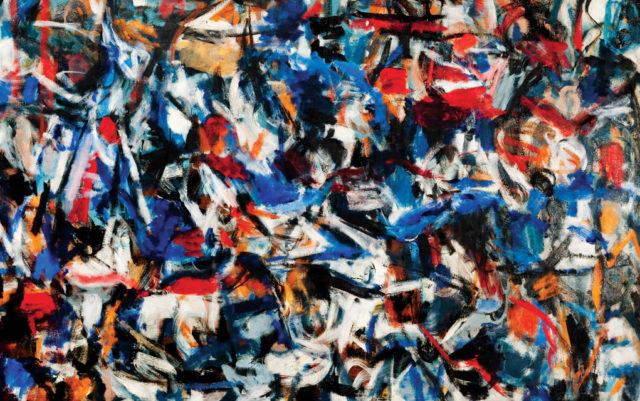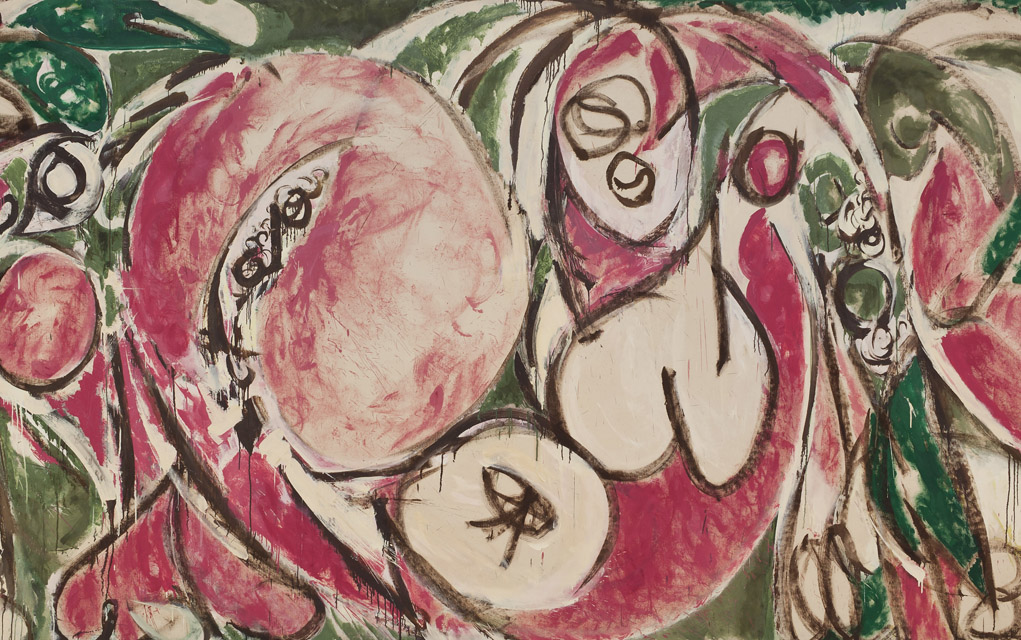
In 1950, leaving behind conscious form, Grace Hartigan took her paints and translated her thoughts on the canvas in a burst of red, blue, yellow, black and white brush strokes. With the title, “The King is Dead,” she referenced the end of Picasso’s cubist reign and celebrated the beginning of the first truly American art movement: abstract expressionism.
The form emerged in the middle of the 20th century, post World War II. Whereas before, artists would migrate to Europe to learn the tricks of the trade, American painters were finally embracing their own styles and shaping their own expressions.
Hartigan was a prolific artist during this period and one of its pioneers, although her name might not necessarily be as familiar as that of artists like Jackson Pollack or Clyfford Still. Hartigan’s work will be featured with 11 other female artists in Women of Abstract Expressionism, on display through Sept. 25 at Denver Art Museum. Joining Hartigan are Mary Abbott, Jay DeFeo, Perle Fine, Helen Frankenthaler, Sonia Gechtoff, Judith Godwin, Elaine de Kooning, Lee Krasner, Joan Mitchell, Deborah Remington and Ethel Schwabacher.

Curator Gwen Chanzit got the idea for the exhibit in 2008 after traveling to New York for another showing of abstract expressionism. She started to wonder about the people who had been left out of the cannon of expressionism, eventually realizing many women of the period had been overlooked. With much research, she decided on these 12 artists who had varying degrees of success in their time, but each who deserve recognition in the movement.
This show is a step toward rectifying the lack of visibility for women artists.
“The art histories have really been lopsided,” Chanzit says. “When I took my first art history survey back in the day, we used Jansen’s History of Art, a huge tome. Not one woman in it, and none of us even thought about it, really. It wasn’t until the mid ’80s that women artists were included.”
Chanzit attributes various reasons for the oversight of women. During the heyday of abstract expressionism, women struggled for equality in most areas of life. The movement is also known for its macho stereotype — for many reasons, but partly due to the rebel cowboy image of Pollack. Some also say that painters at the time didn’t want people to think painting was a feminine activity. With so many contributing factors, it’s almost understandable women were left out, Chanzit says, but fixing it is long overdue.
Women of Abstract Expressionism is the first of its kind at a major museum. Each artist occupies their own space in the gallery and together they demonstrate the wide reaches of the art genre.

But as part of such an individual movement, each artist contributes their own worldview with each work. The themes in the pieces vary from religion, literature, poetry and mythology. And each had their own approach with styles, colors and shapes.
The DAM exhibit intentionally spans 1950 to 1960, seeing as the women of the movement were oft labeled as followers and second-generation newcomers. By keeping focus at the start of the art period, Chanzit helps to remedy those stereotypes and show how these women contributed and pushed it forward. In the ’50s, women were showing in galleries, they were selling some art, but they weren’t always taken seriously.
“They were participating, but they weren’t in the big league — the male-dominated one,” Chanzit says.
They had to combat the gender politics of the time and challenge antiquated rules. Chanzit recounts a relevant story from artist Judith Godwin. When attending college, Godwin complained to the dean about the mandatory dress code, which forced women to wear dresses or skirts in the cafeteria. With only a few minutes between classes, Godwin said it was ridiculous that she had to change out of her pants that she was allowed to wear in the studio.

Furthermore, artists had to deal with backhanded sexists compliments. For example, the famous teacher and painter Hans Hoffman once said to Lee Krasner, “Lee, this painting is so good that you wouldn’t know it was done by a woman.”
The exhibit’s catalogue mentions several women who gave up painting to raise families, even going so far as to destroy their work. That loss of art gives credence to shows like Women of Abstract Expressionism that celebrate the works of the dedicated, yet underappreciated.
Since the exhibit opened, Chanzit says she’s received countless tips about more women artists during this period or in this genre. A textbook author even mentioned that he would be doing a revision of his book to include some of the artists from the show.
Chanzit says she never set out to do a women-only show, but she hopes this is a step in direction, rendering future gendered shows unnecessary. In an effort to figure out who was missing from the expressionism canon, she turned up the spotlight on these unsung artists.
“One of the things I carefully avoided was to give a message about ‘those poor women,’” she says. “That was never the point in this exhibition.”
After Denver, Women of Abstract Expressionism moves on to the Mint Museum in Charlotte, North Carolina, and the Palm Springs Art Museum in California in 2017.
On the Bill: Women of Abstract Expressionism. Denver Art Museum, 100 W. 14th Ave. Parkway, Denver, 720-865-5000. Through Sept. 25.














